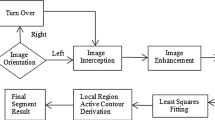Abstract
Automatic pectoral muscle removal on medio-lateral oblique (MLO) view of mammogram is an essential step for many mammographic processing algorithms. However, it is still a very difficult task since the sizes, the shapes and the intensity contrasts of pectoral muscles change greatly from one MLO view to another. In this paper, we propose a novel method based on a discrete time Markov chain (DTMC) and an active contour model to automatically detect the pectoral muscle boundary. DTMC is used to model two important characteristics of the pectoral muscle edge, i.e., continuity and uncertainty. After obtaining a rough boundary, an active contour model is applied to refine the detection results. The experimental results on images from the Digital Database for Screening Mammography (DDSM) showed that our method can overcome many limitations of existing algorithms. The false positive (FP) and false negative (FN) pixel percentages are less than 5% in 77.5% mammograms. The detection precision of 91% meets the clinical requirement.
Similar content being viewed by others
References
Bajger, M., Ma, F., Bottema, M.J., 2005. Minimum Spanning Trees and Active Contours for Identification of the Pectoral Muscle in Screening Mammograms. Proc. Digital Image Computing Techniques and Applications, p.323–329. [doi:10.1109/DICTA.2005.55]
Dominguez, A.R., Nandi, A.K., 2007. Improved dynamicprogramming-based algorithms for segmentation of masses in mammograms. Med. Phys., 34(11):4256–4269. [doi:10.1118/1.2791034]
Ferrari, R.J., Rangayyan, R.M., Desautels, J.E.L., Borges, R.A., Frere, A.F., 2004. Automatic identification of the pectoral muscle in mammograms. IEEE Trans. Med. Imag., 23(2):232–245. [doi:10.1109/TMI.2003.823062]
Glide-Hurst, C.K., Duric, N., Littrup, P., 2007. A new method for quantitative analysis of mammographic density. Med. Phys., 34(11):4491–4498. [doi:10.1118/1.2789407]
Hong, B.W., Brady, M., 2003. A Topographic Representation for Mammogram Segmentation. Medical Image Computing and Computer-Assisted Intervention, p.730–737. [doi:10.1007/b93811]
Karssemeijer, N., 1998. Automated classification of parenchymal patterns in mammograms. Phys. Med. Biol., 43(2):365–378. [doi:10.1088/0031-9155/43/2/011]
Kass, M., Witkin, A., Terzopoulos, D., 1988. Snakes: active contour models. Int. J. Comput. Vis., 1(4):321–331. [doi:10.1007/BF00133570]
Kinoshita, S., Azevedo-Marques, P., Pereira, R., Rodrigues, J., Rangayyan, R., 2007. Radon-domain detection of the nipple and the pectoral muscle in mammograms. J. Dig. Imag., 21(1):37–49. [doi:10.1007/s10278-007-9035-6]
Kwok, S.M., Chandrasekhar, R., Attikiouzel, Y., Rickard, M.T., 2004. Automatic pectoral muscle segmentation on mediolateral oblique view mammograms. IEEE Trans. Med. Imag., 23(9):1129–1140. [doi:10.1109/TMI.2004.830529]
Ma, F., Bajger, M., Slavotinek, J.P., Bottema, M.J., 2007. Two graph theory based methods for identifying the pectoral muscle in mammograms. Pattern Recogn., 40(9):2592–2602. [doi:10.1016/j.patcog.2006.12.011]
Timp, S., van Engeland, S., Karssemeijer, N., 2005. A regional registration method to find corresponding mass lesions in temporal mammogram pairs. Med. Phys., 32(8):2629–2638. [doi:10.1118/1.1984323]
University of South Florida, 2001. Digital Database for Screening Mammography. Available from http://marathon.csee.usf.edu/Mammography/Database.html [Accessed on Jan. 9, 2005].
Xu, W.D., Li, L.H., Liu, W., 2007. A Novel Pectoral Muscle Segmentation Algorithm Based on Polyline Fitting and Elastic Thread Approaching. Proc. 1st Int. Conf. on Bioinformatics and Biomedical Engineering, p.837–840. [doi:10.1109/ICBBE.2007.218]
Yam, M., Brady, M., Highnam, R., Behrenbruch, C., English, R., Kita, Y., 2001. Three-dimensional reconstruction of microcalcification clusters from two mammographic views. IEEE Trans. Med. Imag., 20(6):479–489. [doi:10.1109/42.929614]
Author information
Authors and Affiliations
Corresponding author
Additional information
Project (No. 60505009) supported by the National Natural Science Foundation of China
Rights and permissions
About this article
Cite this article
Wang, L., Zhu, Ml., Deng, Lp. et al. Automatic pectoral muscle boundary detection in mammograms based on Markov chain and active contour model. J. Zhejiang Univ. - Sci. C 11, 111–118 (2010). https://doi.org/10.1631/jzus.C0910025
Received:
Accepted:
Published:
Issue Date:
DOI: https://doi.org/10.1631/jzus.C0910025




